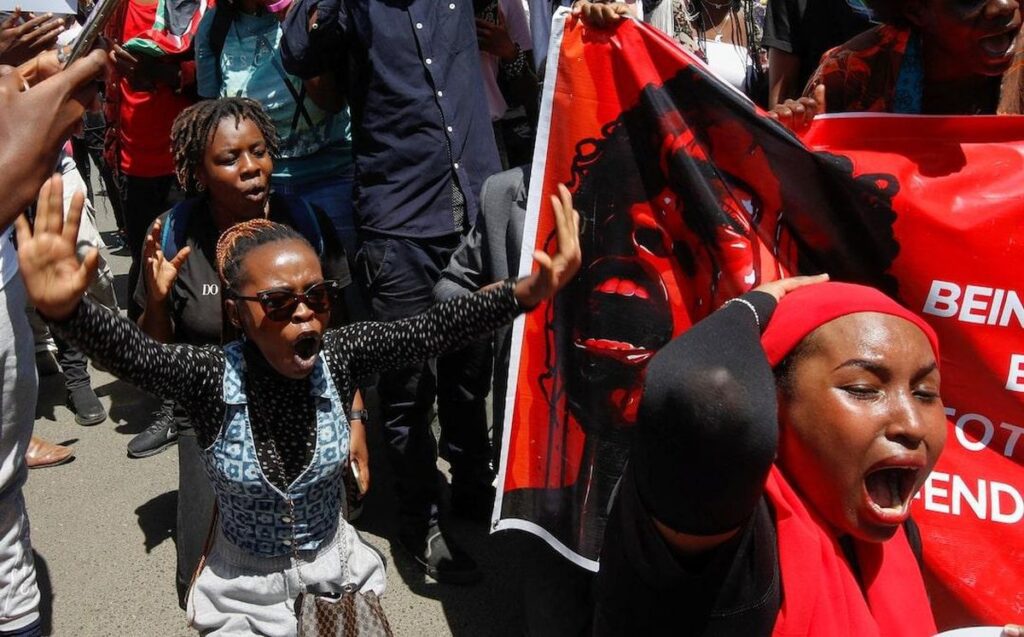## Protesting Against Femicide: Women of Nairobi Demand Justice
The streets of Nairobi resonate with the powerful echoes of protest as courageous voices unite to combat the rising tide of femicide. These demonstrations coincide with the global observance of the 16 Days of Activism Against Gender-Based Violence, which culminates in a powerful call to action against the dire statistics and systemic failures that perpetuate violence against women in Kenyan society.
### The Call to Action
This movement was ignited by a string of brutal murders that highlight the urgency for change. Tragically, these acts of violence gain attention during the UN-sanctioned 16 Days, beginning on November 26, the International Day for the Elimination of Violence Against Women, and concluding on December 10, Human Rights Day. Across this period, campaigns and educational initiatives aim to uplift communities, yet the reality remains harsh: too many Kenyan women face violence, and many remain silent due to fear and societal stigma.
### Alarming Statistics
The statistics are horrifying. According to the UN, femicide—recognized as the most extreme form of gender-based violence—claims the lives of approximately 140 women each day globally. A recent report from the Kenya National Police Service highlights the grim reality within the country, revealing that from just three months, 97 women and girls have been murdered, equating to one woman lost every day. This year’s protests reignited following the tragic death of Olympian Rebecca Cheptegei, brutally killed by her partner, encapsulating the vulnerability that many women endure today.
### Femicide’s Broader Impact
Femicide, defined as the deliberate killing of women because of their gender, reverberates through families and communities, leaving scars that will not easily heal. The heart-wrenching stories of Rebecca Cheptegei, Agnes Tirop, and Damaris Mutua—each a prominent female athlete lost to violence—underscore not only the loss their families face but also the immense void within the community. Every headline that emerges from this tragedy sends shockwaves, calling out for justice for those silenced forever.
### The Fight for Change
Grassroots organizations focused on women’s rights are tirelessly advocating for systemic reforms. Their mission is clear: to dismantle societal norms and attitudes that enable gender-based violence. Significant marches and protests have been orchestrated throughout Kenya, rallying communities together in solidarity against the pervasive violence. Vibrant banners proclaim unity while chants for justice fill the air, directing the attention of lawmakers and leaders to the urgent need for accountability.
### Demand for Action
Local leaders and activists are adamant in their demands for swift governmental response—specifically, the enactment of policies designed to prevent violence against women and reform the damaging societal attitudes that facilitate these crimes. One impassioned activist declared, “We will not rest until there’s justice,” reflecting the determination echoing through the crowd as women speak out for those who have been silenced.
### Confronting Victim-Blaming
Tackling femicide also requires a societal shift to address the troubling phenomenon of victim-blaming, which often undermines women’s voices. Many victims hesitate to report violence due to fear of retaliation and the cultural stigma associated with speaking out. Sadly, for many women, the police, who are entrusted with their protection, often perpetuate barriers through dismissive attitudes. One notable case, the “Justice for Liz” protests from 2013, exemplified this widespread frustration with unresolved cases.
### The Role of Education
The onus to combat violence against women is shared across various sectors, including government, law enforcement, and education. Education is vital in fostering open discussions about the challenges women face, creating safe spaces for reporting incidents, and empowering both young people and community leaders to understand the dynamics surrounding gender-based violence.
### Vital Support Networks
Despite numerous obstacles, organizations advocating for victims’ rights remain crucial in the fight against femicide. They provide essential services like advocacy, legal advice, and counseling for women seeking assistance, proving to be vital lifelines for those escaping abusive circumstances.
### Women’s Resilience in Protest
The protests symbolize the unwavering spirit of women. The women of Kenya marching for justice are united in their mission to forge a new reality. Klara, a protest participant, expressed her deep-seated fears, saying, “Every time I leave home, I fear for my life. We march not just for ourselves but for all women whose voices deserve to be heard.”
### Collective Strength in Marches
These public demonstrations transcend mere events; they embody the strength and unity of women standing against the status quo. Motivated by recent tragedies, these marches facilitate collective expression and demand for systemic reform. Despite ethnic, social, or economic differences, participants stand together in opposition to the culture of violence.
### Amplifying Voices Global
Social media campaigns extend the reach of these protests, drawing international attention to the crisis of violence against women. Hashtags circulate, amplifying voices and showcasing solidarity from supporters worldwide, demonstrating that the fight against femicide is a global issue.
### A Global Issue
The challenge of femicide extends beyond Kenya, rooted in deeply entrenched and institutionalized gender inequalities prevalent in numerous societies. For many women who have lived in fear and witnessed countless headlines reporting horrific murders, the prospect of changing systemic cultural norms can feel daunting. Nonetheless, as the global community seeks solutions, Kenya’s protests serve as a catalyst, sparking important conversations about women’s rights.
### Hope Amid Despair
As the rise of femicide and violence against women stirs urgent reactions, protests proliferate as beacons of hope. Activists remain committed to the belief that meaningful change is achievable through persistent advocacy and public pressure. By pushing boundaries and prompting essential dialogue, they aim to inspire legislative transformations grounded in justice and dignity for women.
### A Determined Struggle
Addressing societal attitudes and institutional failures is undeniably challenging, but the resilience driving this movement is unyielding. The powerful voices of women rise above the violence aimed at silencing them, filling each march with hope—a hope anchored in unity, advocacy, and an unwavering pursuit of justice.


